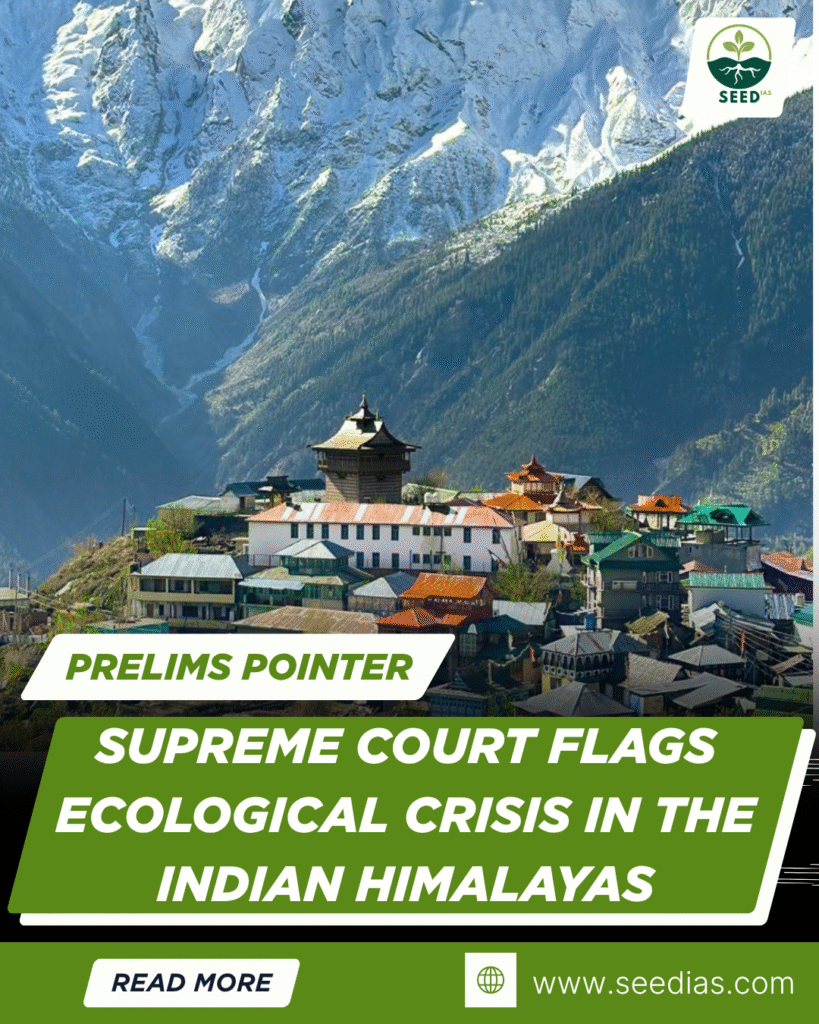Why in NEWS
The Supreme Court has expressed concern over unregulated tourism, reckless infrastructure growth, and ecological degradation in Himachal Pradesh — triggering a broader call for climate-resilient, ecologically sensitive development across the Indian Himalayan Region (IHR).
Key Terms / Concepts
| Term | Explanation |
|---|---|
| Indian Himalayan Region | 2500 km mountain belt across 13 states/UTs; supports 50+ million people |
| Cryosphere | The frozen water part of the Earth system (glaciers, snow, ice caps) |
| Glacial Lake Outburst Flood (GLOF) | Sudden release of water from glacial lakes, often due to glacier melting |
| Ecotourism | Responsible travel promoting conservation and benefiting local communities |
| Van Panchayat | Community-managed forest institution in Uttarakhand |
Key Issues Highlighted by the Supreme Court
| Issue | Details |
|---|---|
| Forest Loss | 1,072 sq km lost (2019–2021); impacts biodiversity, soil stability |
| Drying Springs | 50% natural springs dried up; leads to water crisis (NITI Aayog) |
| Glacier Retreat | 110 glaciers lost in Arunachal Pradesh; increases GLOF risk |
| Landslides & Erosion | Triggered by slope cutting, road widening, rainfall, and deforestation |
| Unregulated Tourism | Hill towns facing waste, traffic, and pressure on fragile ecosystems |
| Development Pressure | Projects like Char Dham Highway weakening geological stability |
India’s Key Initiatives for the Himalayan Region
| Initiative | Objective |
|---|---|
| IHCAP (Indian Himalayas Climate Adaptation Programme) | Climate resilience, knowledge sharing |
| SECURE Himalaya Project | Biodiversity conservation and sustainable livelihood |
| IHDP (Integrated Himalayan Development Program) | Holistic development with ecological balance |
| NMSHE (National Mission on Sustaining the Himalayan Ecosystem) | Part of NAPCC; focuses on glaciers, biodiversity, traditional knowledge |
Measures to Promote Sustainable Development
| Area | Recommended Measures |
|---|---|
| Infrastructure | Eco-sensitive construction, “Build Less, Build Smart”, slope-safe design |
| Water Security | Spring revival, rainwater harvesting, micro-irrigation |
| Tourism | Shift to ecotourism, carrying capacity norms, waste rules enforcement |
| Livelihoods | Train locals in green jobs—guides, handicrafts, eco-hospitality |
| Biodiversity | Community forest management (e.g., Van Panchayats), native species plantation |
| Disaster Resilience | Hazard zonation, early warning systems, climate-proof housing in PMAY (Gramin) |
| Technology | GIS, remote sensing, drones, IoT in hydropower monitoring and tourism management |
In a Nutshell
Memory Code: “CRISP Hills”
- C – Cryosphere collapse
- R – Rainfall-triggered landslides
- I – Infrastructure overload
- S – Springs drying
- P – Policy gaps
- Emphasize “Hills for habitat, not highways”.
Prelims Practice Questions
- Which of the following is NOT a state under the Indian Himalayan Region?
(a) Sikkim
(b) Punjab
(c) Meghalaya
(d) Tripura - Consider the following statements:
- SECURE Himalaya Project is implemented by NITI Aayog.
- NMSHE is part of the National Action Plan on Climate Change.
Which of the above is/are correct?
(a) 1 only
(b) 2 only
(c) Both 1 and 2
(d) Neither 1 nor 2
- Glacial Lake Outburst Floods (GLOFs):
(a) Are caused only due to cloudbursts
(b) Occur due to sudden release of water from melting glaciers
(c) Have no impact on downstream settlements
(d) Are declining due to climate change
Prelims Answer Key
| Q No. | Answer | Explanation |
|---|---|---|
| 1 | (b) | Punjab is not part of the Indian Himalayan Region |
| 2 | (b) | NMSHE is under NAPCC; SECURE Himalaya is a MoEFCC-UNDP-GEF project |
| 3 | (b) | GLOFs occur when glacial lakes breach due to melting or pressure buildup |
















